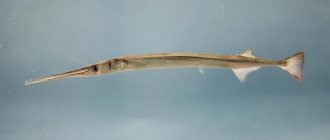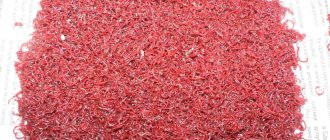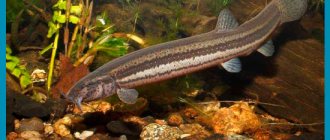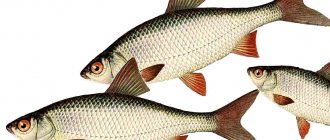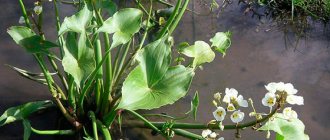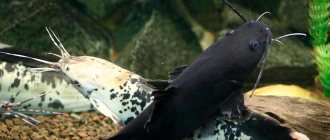The loach fish is one of the largest representatives of the cyprinid order. It’s not easy to agree with this, because outwardly loaches look more like eels or even snakes. They also wriggle a lot, which has earned them the dislike of fishermen and, on the contrary, the love of aquarists. Thanks to the loaches, a feeling of permanent movement is created in the aquarium.
Aquarium fish loach
On a note ! Loaches are believed to predict the weather, which is why they are also called “barometers.” About 24 hours before a thunderstorm, the fish rise to the surface of the aquarium, begin to rush in different directions and gasp for air. They sense changes in atmospheric pressure and signal this as best they can.
When you first meet a loach, it may not make the best impression - almost all people are instinctively afraid of snakes, which the fish described in the article resemble. But since loaches are completely harmless, aquarists turn a blind eye to stereotypes by purchasing and breeding these fish.
The first acquaintance with a loach may not leave the best impressions
Description of the loach
A representative of the order Cypriniformes, associated with a snake or an eel, is characterized by a finger-thick body of an elongated shape (15–20, sometimes up to 30 cm), without scales or with smooth small scales, which are often barely visible due to the large layer of mucus on it.
This unattractive appearance is complemented by very small eyes located on a small head compressed on both sides, and thread-like antennae above a large round mouth, six of which are located above the upper lip, and four under the lower lip. The color of the back is yellowish-brown with black speckles, the belly is yellow, less often reddish, and the fins are brown. On the sides of the body along the entire length there are black stripes, the middle of which is much wider than the outer ones. The lifespan of a loach is up to 7 years.
By the way, if you place this fish in clean, transparent water, its body acquires a brighter color. As an exception, albino loaches are quite rare in nature.
No. 5 Installing an additional engine mount
The additional support is installed together with the front strut brace, which has two functions:
- increasing the rigidity of the front body;
- limiting the amplitude of oscillations of the power unit.
The spacer relieves the work of the right support and increases its service life. To install, you will need to modify the frill (cut the plastic in place).
Price: 2200 RUR (with additional pillow)
- How to replace the right Vesta engine mount
- Review of Vesta's reinforced lower engine mounts
Keywords: Lada Vesta engine | soundproofing Lada Vesta
2
Found an error? Select it and press Ctrl+Enter..
Loach habitat
The loach (fish) lives in quiet places where there is at least some amount of liquid muddy soil - these are swamps, river oxbows, ditches and holes, deep muddy lakes, swampy creeks, muddy channels, small quiet rivers.
In dry times, the loach burrows into the wet mud remaining at the bottom of dried-up ponds and streams to a depth of about one to two meters and falls into a state of hibernation there, which stops with the arrival of rains. Just as trout cannot live without running clean water, so the loach is unable to live without silt and mud, which serve as its favorite refuge.
Loach's ability to survive
The loach is a fish that in the natural environment is a very tenacious individual with amazing resourcefulness. When small bodies of water dry up and most of their inhabitants die, only loaches survive, which are distinguished by their unpretentiousness in maintenance. If there is a lack of oxygen in the water, the loach goes into second wind; The respiratory function is performed by the hind intestine. To do this, the loach fish rises to the water surface, swallows air through its mouth, passes it through the digestive canal and releases it through the respiratory opening, which helps it make squeaking sounds. This squeak is especially heard in the summer, when loaches crawl from drying reservoirs to other nearby ones. It is difficult to see a loach in such extreme conditions for it. But you can find it if you go into a puddle and feel the bottom. A caught fish, even a small one, must be held firmly with both hands, since it is very nimble and can slip out and hide in the mud.
If you manage to pull out the loach and pick it up, it will begin to squeak. It was this quality that served as the reason for giving him a second name - “squeaker”. Even fish-eating birds, who flock to small bodies of water to have a tasty and hearty lunch, know about this accessible method of obtaining loaches during a drought.
Loach is a fish that is highly adaptable and able to survive in any conditions, enduring the winter cold. Such a fish can even live without food for about six months. Loaches live for a long time in a cage with a small amount of water and wet grass.
Acantophthalmus diseases
This species is more susceptible to disease than many other aquarium fish. It is believed that this predisposition may be due to the lack of scales on their body and head.
They are incredibly sensitive to chemicals, antibiotics and other elements in the water. This is why filtration systems are so important to their survival and health.
An individual suspected of having the disease should be immediately placed in a separate tank, which is best kept always ready, since Acantophthalmus often gets sick.
Sudden changes in temperature, colder water, etc. increase their likelihood of contracting something unpleasant.
The most common disease in this species is “white spot disease,” which is caused by the parasitic ciliate lchthyophthirius multifiliis. Small white dots up to 1 mm in size appear on the fish.
The parasite attacks the fins and from there spreads gradually throughout the fish’s body. Parasites often attack the gills, making breathing difficult.
Due to the increased sensitivity of Acantophthalmus, the dosage of medications for their treatment is reduced either by half or given less than the standard dose.
Fish are also very susceptible to something called Skinny Disease. This disease can be diagnosed quite easily - Acantophthalmus loses weight, despite proper nutrition.
This disease is caused by internal parasites and must be treated with antibiotics.
Conclusion
These beautiful fish require special attention as they are very susceptible to disease if not kept in a proper environment with good oxygenation and frequent water changes.
Breeding Acantophthalmus is very difficult, but it can be useful for gaining invaluable experience if successful.
What does loach fish eat?
The food for these nimble fish are small mollusks, bloodworms, crustaceans, insect larvae and even bottom vegetation. He retrieves it from the bottom and only before the onset of bad weather floats to the surface, swimming fussily and gasping for air. It is by this sign that fishermen accurately determine the upcoming worsening of the weather. The loach reacts sensitively to changes in atmospheric pressure and, when bad weather approaches, begins to get very worried and poke its head out to the surface countless times. Loaches are a kind of natural barometer, and some lovers of beauty keep them in aquariums, where they adapt well. In anticipation of bad weather, the aquarium fish loach bends into an arch and swims restlessly near the surface, and the loach is capable of remaining in this state for quite a long time. In Japan, their behavior determines not only the future worsening of the weather, but also the approach of earthquakes and tsunamis.
Nutrition
It feeds on insect larvae (especially chironomids), crustaceans, worms, small mollusks, as well as detritus and partially bottom vegetation. In captivity it can live without food for up to six months.
. In addition, the loach is known as an active eater of alien eggs. Hardly any inhabitant of rivers and lakes can compete with it in its ability to find it at the bottom. He does this so actively that in small bodies of water other fish often completely disappear. Crucian carp, carp, and tench suffer the most from loaches.
In an aquarium, the loach is voracious (as in the wild) and greedily grabs bloodworms, raw meat, earthworms, ant eggs, and picks up food only from the bottom. He finds food by touch (on his head around his mouth he has 10 antennae, which serve as the main organs of touch).
Keeping loaches in an aquarium
Loach fish in an aquarium are often kept separately from other individuals due to their restless behavior. She treats any aquarium vegetation normally, does not spoil its leaves and does not feed on them. It is advisable to lay several driftwood at the bottom to create an artificial stone grotto. It is also advisable to create a shaded area among the plants, as close as possible to natural conditions; it is in such an environment that the loach fish will feel comfortable in the aquarium. What to feed a freshwater river representative? Since the fish is bottom-dwelling, it will need heavy food: worms, special dry or frozen food, as well as herbal supplements. This is how it is - a picky loach (fish) that adapts to any conditions. What should I feed her? Any food, because she is an omnivore.
Chemicals
How to fight mealybugs on orchids with ready-made preparations? You can get rid of parasites using various chemicals that have an intestinal contact effect on them. Young insects are not yet covered with a durable protective wax coating. Therefore, the contact insecticide instantly destroys their shell only when it gets on it.
Thanks to the use of enteric-contact chemical compounds, treatment becomes many times more effective. According to reviews from flower growers, these drugs can remove all parasites from indoor flowers and allow you to cope with the scourge much faster.
How to treat an orchid against mealybug? You can use drugs:
- “Fitoverm”.
- "Vertimek".
- "Aktellik".
Orchids are also treated with “Aktara” against mealybugs. An insecticide that belongs to the group of neonicotinoids allows you to effectively combat pests, more precisely their larvae, which can hatch from eggs that are laid deep in the substrate.
According to the instructions, “Fitoverm” and “Vermitek” are classified as drugs that are characterized by an intestinal-contact mode of action on parasites. Their toxicity is not as great as that of other chemicals that are used to treat plants affected by mealybugs. According to the instructions, “Fitoverm” does not pollute the environment and quickly breaks down in soil and water.
Loach – natural barometer
And yet, why do loaches, which rarely rise to the surface, exhibit such strange behavior when bad weather approaches? Fishermen noticed that before bad weather the loach becomes restless. The fish begins to swim quickly in shallow water, raising bottom silt. Before a rain or thunderstorm, the loach makes circular movements near the surface of the water. This is explained by a change in atmospheric pressure, which the fish perceives very strongly through the skin, which, in turn, transmits the impulse through channels filled with lymph and affects the walls of the swim bladder. It is connected through a system of bones to the organ of balance – the inner ear. The ability of the loach to determine the weather has been noticed by people for a long time. In good weather, the fish lie calmly on the bottom. And on the eve of bad weather, especially a thunderstorm, their behavior becomes greatly intensified: they begin to rush around the aquarium, constantly rise to the surface, then sink to the bottom again. If on the eve of clear weather the loach floats to the surface once every quarter of an hour, then before bad weather - up to 20 times within a minute.
Experienced fishermen, focusing on the behavior of the loach, note that in bad weather fish such as pike, perch, ruff, and chub are caught well - precisely during a thunderstorm.
Reproduction
The loach fish reproduces in the spring-summer period, and the females swim into the floods to spawn, and the hatched larvae can then be found far from the lake or river. The female is capable of laying from 100 to 150 thousand eggs.
She does this in algae thickets, the water temperature is 14–16 oC. The incubation period is 4 days. The hatched larvae, which are 6.9 mm long, are equipped with adhesive organs and additional respiratory organs - external gills. In addition, the respiratory function in the larvae is also performed by blood vessels located in the anal fold, large pectoral fins and, a little later, the hind intestine. When the larvae reach the age of 12 days and a body length of 8 mm, they switch to external feeding and find food using special sensory organs located around the mouth and on already developed antennae. When the larva reaches 26 days, its external gills completely disappear. The fish turn into fry when the larva reaches 30 cm in length.
Loach as bait for larger fish
Fishermen catch loach, which easily swallows a hook with bait (dung or earthworm), using fishing rods (float and bottom), fishing line with a diameter of 0.15-0.25 mm, hooks No. 5. The nozzle must be lowered to the very bottom, without worrying at all, that, immersed in the silt, it will become invisible - the loach will still find it. In places where there are large concentrations of loaches, they are excellent at taking a worm bait; they can also be tempted by a bare hook. Loaches peck at any time of the day, so catching them is not difficult. There are few hunters to catch this particular fish; Mostly it is caught as bait for large prey: pike, burbot, catfish and especially eel, which bite well on this baitfish. By the way, a loach, while on a hook, can remain alive and active for more than a day. As bait, loaches can be kept in stock for about a week, the main thing is to pour no more than 4-9 cm of water into the bucket where they are kept, and put fresh grass on top: nettle, wheatgrass, sedge. The water needs to be changed twice a day.
Acantophthalmus Myers
Distribution : Thailand, Laos, Cambodia.
On its orange body it has 8-11 very wide, quadrangular, regular stripes of dark color; black or with a large black spot at the base of the caudal fin.
Common name : giant coolies, Myers loach, Myers coolies.
Sexual dimorphism : females, as well as other Pangio species, become noticeably plump during pregnancy. Caviar can be seen in the abdominal cavity.
Maximum size: 10 cm.
Similarities to Other Species: The immature fish may be confused with other striped coulees. Adults do not raise any doubts.
Maintenance and Care : All Coolies require established aquariums and should not be placed in new ones. It is necessary to create many secluded places for them with a soft substrate. It is best kept in groups, and the larger the group, the better. Three individuals is the absolute acceptable minimum for their coexistence.
Feeding : good quality flakes, sinking granules, bloodworms thawed after freezing, brine shrimp, etc.
Water requirements : from 6.5-7.2 pH; hardness: from 5-12° dH.
Temperature: from +25-28° C.
Reproduction: females noticeably gain weight from the eggs. The male courts the female, wrapping his body around her. Green eggs are deposited in floating vegetation. The fry hatch in about 24 hours.
Useful properties of loach fish
Loach fish (the photo gives you the opportunity to admire it) is considered to be of little value and is only eaten occasionally, because it is greatly neglected, which, however, it does not deserve. Its meat is tasty and tender and resembles tench: without small bones, fatty, sweet, juicy. True, it almost always smells like mud, and in connection with this, some fishermen are engaged in breeding loaches in special digging ponds. Before cooking, it is advisable to rinse the fish thoroughly with running water, after clearing the mucus with ash. Most often, fish soup is made from loaches; They are fried very rarely, although in Japan and France this fish is specially grown and is considered a real delicacy. Cooked loach dishes are sources of many nutritional components:
- vitamin A, necessary to ensure the health of the mucous membranes and the process of producing sex hormones;
- vitamin B, which increases overall tone and strengthens the heart muscle;
- vitamin D, which ensures healthy and proper growth of the skeleton and teeth;
- vitamin B, which normalizes the functioning of the nervous system and the processes of carbohydrate and energy metabolism;
- magnesium, potassium, fluorine, zinc, calcium, iodine;
- unsaturated fatty acids and amino acids that favor the functioning of the cardiovascular system and normalize cholesterol levels.
Loach fish has another very useful quality: it eats large quantities of mosquito larvae, including malaria ones. In this ability, the fish is not inferior even to the gambusia, imported from America and acclimatized to local conditions specifically for this purpose.
Compatibility with plants and fish
Acanthus are peaceful fish that pose no threat to other underwater inhabitants. Proximity with large aggressive predators or territorial fish is not recommended. Although the pangio can fend for itself just fine, the sharp spine on its head will cause the fish to spit out its prey. If the prickly eye is swallowed whole by a large fish or bird, it will resist to the last and, in the process of freeing itself, will pierce the stomach and skin of the attacker and get out.
Acanthophthalmus Kühl has good compatibility with fish that live in the upper or middle layers of water. These can be gourami, zebrafish, tetras, guppies, swordtails, apistograms, thornets.
This species is peaceful
Completely incompatible with catfish, cichlids, mollies, nannakars, astronotuses, yellow labidochromis, and clown fish.
Pangios prefer surface vegetation such as tiger water lilies that shade the water area, as well as Java moss or Thai fern bushes.


